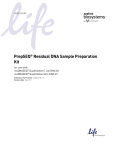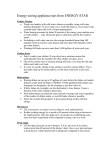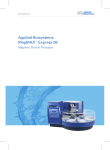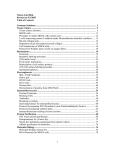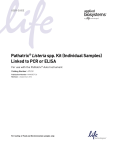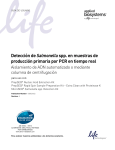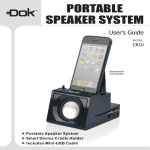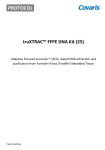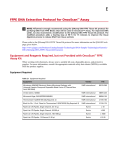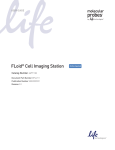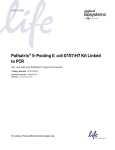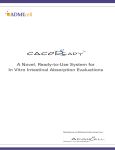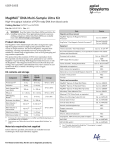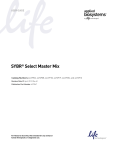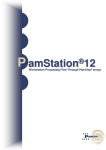Download PrepSEQ® Residual DNA Sample Preparation Kit User Guide (Pub
Transcript
USER GUIDE PrepSEQ® Residual DNA Sample Preparation Kit For use with: resDNASEQ® Quantitative CHO DNA kit resDNASEQ® Quantitative E. coli DNA kit resDNASEQ® Quantitative Human DNA kit resDNASEQ® Quantitative Vero DNA kit resDNASEQ® Quantitative Pichia DNA kit resDNASEQ® Quantitative NS0 DNA kit resDNASEQ® Quantitative MDCK DNA kit Publication Number 4469838 Revision C For Research Use Only. Not for use in diagnostic procedures. For Research Use Only. Not for use in diagnostic procedures. The information in this guide is subject to change without notice. DISCLAIMER LIFE TECHNOLOGIES CORPORATION AND/OR ITS AFFILIATE(S) DISCLAIM ALL WARRANTIES WITH RESPECT TO THIS DOCUMENT, EXPRESSED OR IMPLIED, INCLUDING BUT NOT LIMITED TO THOSE OF MERCHANTABILITY, FITNESS FOR A PARTICULAR PURPOSE, OR NON-INFRINGEMENT. TO THE EXTENT ALLOWED BY LAW, IN NO EVENT SHALL LIFE TECHNOLOGIES AND/OR ITS AFFILIATE(S) BE LIABLE, WHETHER IN CONTRACT, TORT, WARRANTY, OR UNDER ANY STATUTE OR ON ANY OTHER BASIS FOR SPECIAL, INCIDENTAL, INDIRECT, PUNITIVE, MULTIPLE OR CONSEQUENTIAL DAMAGES IN CONNECTION WITH OR ARISING FROM THIS DOCUMENT, INCLUDING BUT NOT LIMITED TO THE USE THEREOF. Limited Use Label License No. 492: Environmental Testing, Quality Control/Quality Assurance Testing, Food and Agricultural Testing Notice to Purchaser: The purchase of this product conveys to the purchaser the limited, non-transferable right to use the purchased amount of the product (a) to perform internal research for the sole benefit of the purchaser; and (b) for environmental testing, quality control/quality assurance testing, food and agricultural testing, including reporting results of purchaser's activities in environmental testing, quality control/quality assurance testing, food and agricultural testing for a fee or other commercial consideration. No other right is hereby granted expressly, by implication, or by estoppel. This product is for environmental testing, quality control/ quality assurance testing, food and agricultural testing and research purposes only. The purchase of this product does not grant the purchaser any additional rights, including (without limitation) the right to transfer or resell the product in any form or the right to use the product as a therapeutic agent or diagnostics test component. For information on obtaining additional rights, please contact [email protected] or Out Licensing, Life Technologies, 5791 Van Allen Way, Carlsbad, California 92008. TRADEMARKS All trademarks are the property of Thermo Fisher Scientific and its subsidiaries unless otherwise specified. AmpliTaq Gold and TaqMan are registered trademarks of Roche Molecular Systems, Inc. TaqMan used under permission and license. Microsoft and Windows are registered trademarks of Microsoft Corporation. © 2014 Thermo Fisher Scientific Inc. All rights reserved. Contents About This Guide . . . . . . . . . . . . . . . . . . . . . . . . . . . . . . . . . . . . . . . . . . . . . . . . 5 Revision history . . . . . . . . . . . . . . . . . . . . . . . . . . . . . . . . . . . . . . . . . . . . . . . . . . . . . . . . . . . . . . . . . . . . . . . 5 Purpose . . . . . . . . . . . . . . . . . . . . . . . . . . . . . . . . . . . . . . . . . . . . . . . . . . . . . . . . . . . . . . . . . . . . . . . . . . . . . . 5 Prerequisites . . . . . . . . . . . . . . . . . . . . . . . . . . . . . . . . . . . . . . . . . . . . . . . . . . . . . . . . . . . . . . . . . . . . . . . . . 5 ■ CHAPTER 1 PrepSEQ® Residual DNA Sample Preparation Kit . . . . . . 7 Product description . . . . . . . . . . . . . . . . . . . . . . . . . . . . . . . . . . . . . . . . . . . . . . . . . . . . . . . . . . . . . . . . . . . . 7 Kit contents and storage . . . . . . . . . . . . . . . . . . . . . . . . . . . . . . . . . . . . . . . . . . . . . . . . . . . . . . . . . . . . . . . . 8 Required materials . . . . . . . . . . . . . . . . . . . . . . . . . . . . . . . . . . . . . . . . . . . . . . . . . . . . . . . . . . . . . . . . . . . . 9 Automation instrument, plastics, and accessories . . . . . . . . . . . . . . . . . . . . . . . . . . . . . . . . . . . . . 9 Required materials not included in the kit . . . . . . . . . . . . . . . . . . . . . . . . . . . . . . . . . . . . . . . . . . . 10 Workflow for residual DNA extraction (manual or automated) from CHO, E. coli, Human, Vero, Pichia, NSO, and MDCK . . . . . . . . . . . . . . . . . . . . . . . . . . . . . . . . . . . . . . . . . . . . . . . . . . . . . . . . . . . . . . . . . . . . . . 11 Prepare reagents . . . . . . . . . . . . . . . . . . . . . . . . . . . . . . . . . . . . . . . . . . . . . . . . . . . . . . . . . . . . . . . . . . . . . 11 Prepare magnetic beads . . . . . . . . . . . . . . . . . . . . . . . . . . . . . . . . . . . . . . . . . . . . . . . . . . . . . . . . . . 11 PrepSEQ® Binding Solution . . . . . . . . . . . . . . . . . . . . . . . . . . . . . . . . . . . . . . . . . . . . . . . . . . . . . . . . 11 PrepSEQ® Wash Buffer Concentrate . . . . . . . . . . . . . . . . . . . . . . . . . . . . . . . . . . . . . . . . . . . . . . . . 11 Proteinase K/Proteinase K Buffer mix . . . . . . . . . . . . . . . . . . . . . . . . . . . . . . . . . . . . . . . . . . . . . . 11 Lysis Solution Mix of Lysis Buffer, tRNA, and glycogen . . . . . . . . . . . . . . . . . . . . . . . . . . . . . . . . . 12 Dilute test samples (if necessary) . . . . . . . . . . . . . . . . . . . . . . . . . . . . . . . . . . . . . . . . . . . . . . . . . . . . . . . 12 Prepare triplicate reactions . . . . . . . . . . . . . . . . . . . . . . . . . . . . . . . . . . . . . . . . . . . . . . . . . . . . . . . . . . . . 12 (Recommended) Prepare the extraction controls . . . . . . . . . . . . . . . . . . . . . . . . . . . . . . . . . . . . 13 Guidelines for best yields . . . . . . . . . . . . . . . . . . . . . . . . . . . . . . . . . . . . . . . . . . . . . . . . . . . . . . . . . . . . . . 14 Manual protocol for residual DNA extraction . . . . . . . . . . . . . . . . . . . . . . . . . . . . . . . . . . . . . . . . . . . . . 14 Prepare and digest the samples . . . . . . . . . . . . . . . . . . . . . . . . . . . . . . . . . . . . . . . . . . . . . . . . . . . . 14 Bind the DNA . . . . . . . . . . . . . . . . . . . . . . . . . . . . . . . . . . . . . . . . . . . . . . . . . . . . . . . . . . . . . . . . . . . . 15 Wash the DNA . . . . . . . . . . . . . . . . . . . . . . . . . . . . . . . . . . . . . . . . . . . . . . . . . . . . . . . . . . . . . . . . . . . 15 Elute the DNA . . . . . . . . . . . . . . . . . . . . . . . . . . . . . . . . . . . . . . . . . . . . . . . . . . . . . . . . . . . . . . . . . . . 15 Automated protocol for residual DNA extraction . . . . . . . . . . . . . . . . . . . . . . . . . . . . . . . . . . . . . . . . . . 16 Troubleshooting . . . . . . . . . . . . . . . . . . . . . . . . . . . . . . . . . . . . . . . . . . . . . . . . . . . . . . . . . . . . . . . . . . . . . . 18 ■ APPENDIX A Good Laboratory Practices . . . . . . . . . . . . . . . . . . . . . . . . 19 Residual DNA quantification . . . . . . . . . . . . . . . . . . . . . . . . . . . . . . . . . . . . . . . . . . . . . . . . . . . . . . . . . . . 19 Diluting test samples for residual DNA sample preparation . . . . . . . . . . . . . . . . . . . . . . . . . . . . 19 Preparing serial dilutions and a standard curve . . . . . . . . . . . . . . . . . . . . . . . . . . . . . . . . . . . . . . 19 PrepSEQ® Residual DNA Sample Preparation Kit User Guide 3 Contents Preventing PCR contamination . . . . . . . . . . . . . . . . . . . . . . . . . . . . . . . . . . . . . . . . . . . . . . . . . . . . . . . . . 19 Avoiding false positives due to cross-contamination . . . . . . . . . . . . . . . . . . . . . . . . . . . . . . . . . . 20 Plate layout suggestions . . . . . . . . . . . . . . . . . . . . . . . . . . . . . . . . . . . . . . . . . . . . . . . . . . . . . . . . . . . . . . 20 ■ APPENDIX B Safety . . . . . . . . . . . . . . . . . . . . . . . . . . . . . . . . . . . . . . . . . . 21 Chemical safety . . . . . . . . . . . . . . . . . . . . . . . . . . . . . . . . . . . . . . . . . . . . . . . . . . . . . . . . . . . . . . . . . . . . . . 22 Specific chemical handling . . . . . . . . . . . . . . . . . . . . . . . . . . . . . . . . . . . . . . . . . . . . . . . . . . . . . . . . 23 Biological hazard safety . . . . . . . . . . . . . . . . . . . . . . . . . . . . . . . . . . . . . . . . . . . . . . . . . . . . . . . . . . . . . . . 23 Documentation and Support . . . . . . . . . . . . . . . . . . . . . . . . . . . . . . . . . . . . . 25 Related documentation . . . . . . . . . . . . . . . . . . . . . . . . . . . . . . . . . . . . . . . . . . . . . . . . . . . . . . . . . . . . . . . 25 Obtaining SDSs . . . . . . . . . . . . . . . . . . . . . . . . . . . . . . . . . . . . . . . . . . . . . . . . . . . . . . . . . . . . . . . . . . . . . . 25 Obtaining support . . . . . . . . . . . . . . . . . . . . . . . . . . . . . . . . . . . . . . . . . . . . . . . . . . . . . . . . . . . . . . . . . . . . 25 Limited product warranty . . . . . . . . . . . . . . . . . . . . . . . . . . . . . . . . . . . . . . . . . . . . . . . . . . . . . . . . . . . . . . 26 4 PrepSEQ® Residual DNA Sample Preparation Kit User Guide About This Guide IMPORTANT! Before using this product, read and understand the information in the “Safety” appendix in this document. Revision history Revision Date B January 2013 Description Add the following kits: • resDNASEQ® Quantitative CHO DNA Kit (Cat. no. 4402085) • resDNASEQ® Quantitative E. coli DNA Kit (Cat. no. • 4458435) • resDNASEQ® Quantitative Vero DNA Kit (Cat. no. • 4458444) C December 2014 Add the resDNASEQ® Quantitative Human DNA Kit (Cat. no. A26366) Purpose This guide provides step-by-step instructions for using the PrepSEQ® Residual DNA Sample Preparation Kit to efficiently extract genomic DNA from diverse sample types, including samples that contain high protein and low DNA concentration. Prerequisites This guide uses conventions and terminology that assume a working knowledge of the Microsoft® Windows® operating system, the Internet, and Internet-based browsers. PrepSEQ® Residual DNA Sample Preparation Kit User Guide 5 About This Guide Prerequisites 6 PrepSEQ® Residual DNA Sample Preparation Kit User Guide PrepSEQ® Residual DNA Sample Preparation Kit 1 ■ Product description . . . . . . . . . . . . . . . . . . . . . . . . . . . . . . . . . . . . . . . . . . . . . . . . . . . . 7 ■ Kit contents and storage . . . . . . . . . . . . . . . . . . . . . . . . . . . . . . . . . . . . . . . . . . . . . . . . 8 ■ Required materials . . . . . . . . . . . . . . . . . . . . . . . . . . . . . . . . . . . . . . . . . . . . . . . . . . . . . 9 ■ Workflow for residual DNA extraction (manual or automated) from CHO, E. coli, Human, Vero, Pichia, NSO, and MDCK . . . . . . . . . . . . . . . . . . . . . . . . . . . . . . . . . . 11 ■ Prepare reagents . . . . . . . . . . . . . . . . . . . . . . . . . . . . . . . . . . . . . . . . . . . . . . . . . . . . . . 11 ■ Guidelines for best yields . . . . . . . . . . . . . . . . . . . . . . . . . . . . . . . . . . . . . . . . . . . . . . 14 ■ Manual protocol for residual DNA extraction . . . . . . . . . . . . . . . . . . . . . . . . . . . . . 14 ■ Automated protocol for residual DNA extraction . . . . . . . . . . . . . . . . . . . . . . . . . 16 ■ Dilute test samples (if necessary) . . . . . . . . . . . . . . . . . . . . . . . . . . . . . . . . . . . . . . . . 12 ■ Troubleshooting . . . . . . . . . . . . . . . . . . . . . . . . . . . . . . . . . . . . . . . . . . . . . . . . . . . . . . 18 Product description The PrepSEQ® Residual DNA Sample Preparation Kit extracts host-cell DNA from products produced in cell lines such as CHO, E. coli, Human, Vero, Pichia, NS0, and MDCK. The kit uses chemical lysis and magnetic beads to efficiently extract genomic DNA from diverse sample types, including samples that contain high protein and low DNA concentration. To ensure accurate quantitative results, Life Technologies™ protocols call for true triplicate sample preparation and analysis. Extract each test sample in triplicate and perform a single PCR reaction for each extraction. The instrument software calculates a mean quantity. You can calculate the percent coefficient of variation from this data (SD/Mean Quantity) × 100 = % CV). Based on this calculation, you can then assign a % CV value that indicates acceptable reproducibility. After extraction, you can quantitate the DNA to determine the level of host-cell DNA contamination in the product. For quantitation of host-cell line residual DNA, we recommend using the resDNASEQ® Quantitative DNA kits as described in the resDNASEQ® Quantitative DNA Kits User Guide (Pub. no. 4469836). PrepSEQ® Residual DNA Sample Preparation Kit User Guide 7 1 Chapter 1 PrepSEQ® Residual DNA Sample Preparation Kit Kit contents and storage Kit contents and storage WARNING! Read the Safety Data Sheets (SDSs) and follow the handling instructions. Wear appropriate protective eyewear, clothing, and gloves. Safety Data Sheets (SDSs) are available from www.lifetechnologies.com/support. The PrepSEQ® Residual DNA Sample Preparation Kit (Cat. no. 4413686) contains the PrepSEQ® Nucleic Acid Extraction Kit (Cat. no. 4400799, three boxes) and the PrepSEQ® Residual DNA Sample Preparation Kit (Cat. no. 4399042, one box). Kit components include: Reagent Description Storage Box 1, PrepSEQ® Nucleic Acid Extraction Kit 4400793 Lysis Buffer 2 bottles, 50 mL/bottle Store at room temperature. 4400659 Binding Solution (Isopropanol) 1 empty bottle NA 4400789 Wash Buffer Concentrate 2 bottles, 26 mL/bottle Store at room temperature. 4400783 Elution Buffer 1 bottle, 25 mL Store at room temperature. 4400784 Proteinase K (PK) Buffer 1 bottle, 50 mL Store at room temperature. 4400787 Box 2, PrepSEQ® Magnetic Particles Box 3, PrepSEQ® Proteinase K PrepSEQ® 8 Cat. no. Nucleic Acid Extraction Kit 2 tubes, 1.5 mL/tube 4400795 Store at room temperature. Nucleic Acid Extraction Kit 1 tube, 20 mg/mL, 1.25 mL 4401405 4400675 Store at or below – 20°C. Residual DNA Sample Preparation Kit 4403958 4399042 Proteinase K 1 tube, 20 mg/mL, 1.25 mL Store at or below – 20°C. 4403958 Yeast tRNA 1 tube, 10 mg/mL, 0.5 mL Store at or below – 20°C. 4404626 Glycogen 2 tubes, 5 mg/mL, 1.0 mL/tube Store at or below – 20°C. 4404627 PrepSEQ® Residual DNA Sample Preparation Kit User Guide Chapter 1 PrepSEQ® Residual DNA Sample Preparation Kit Required materials 1 Required materials WARNING! Read the Safety Data Sheets (SDSs) and follow the handling instructions. Wear appropriate protective eyewear, clothing, and gloves. Safety Data Sheets (SDSs) are available from www.lifetechnologies.com/support. Automation instrument, plastics, and accessories The MagMAX™ Express-96 DW instrument (Cat. no. 4456933) accessories include: Item Source or Cat. no. MagMAX™ Express-96 DW plate 4388476 MagMAX™ Express-96 DW well tip combs 4388487 MagMAX™ Express-96 DW magnetic head 4388435 MagMAX™ Express-96 DW standard plates 4388475 Magnetic Stand-96 PrepSEQ® Residual DNA Sample Preparation Kit User Guide AM10027 9 1 Chapter 1 PrepSEQ® Residual DNA Sample Preparation Kit Required materials Required materials not included in the kit Item Source or Cat. no. Equipment Block heater for use with 2-mL tubes. Manual DNA extraction involves two incubations at different settings, so two heaters may be convenient. Major laboratory supplier (MLS) Magnetic stand, 16-position 4457858 Benchtop microcentrifuge for 1.5-mL and 2-mL tubes MLS Vortex-Genie 2T Mixer VWR 14216-188, VWR 14216-186 Vortex Adapter-60, for use with the Vortex-Genie AM10014 Consumables Disposable gloves MLS Aerosol-resistant micropipette tips MLS Pipetman® Pipettors, P1000, P200, P20 and P10: MLS • Positive-displacement • Air-displacement • Multichannel Nonstick, RNase-free Microfuge Tubes, 1.5-mL (1 box; 250 tubes/box) AM12450 Safe-Lock PCR clean microcentrifuge tubes, roundbottom, 2-mL VWR 62111-754 Reagents Ethanol, 95% MLS IMPORTANT! Do not use denatured ethanol. It contains components that are not compatible with the protocol. 10 Isopropanol, 100% MLS 5 M NaCl and 1 N NaOH solutions MLS Hydrochloric acid (HCI) MLS PBS solution, 1X, pH 7.4, free of Mg and Ca (if needed to dilute samples) AM9624 PrepSEQ® Residual DNA Sample Preparation Kit User Guide Chapter 1 PrepSEQ® Residual DNA Sample Preparation Kit Workflow for residual DNA extraction (manual or automated) from CHO, E. coli, Human, Vero, Pichia, NSO, and MDCK 1 Workflow for residual DNA extraction (manual or automated) from CHO, E. coli, Human, Vero, Pichia, NSO, and MDCK Workflow for manual residual DNA extraction Workflow for automated residual DNA extraction on the MagMAX™ Express-96 DW instrument Prepare reagents (page 11) Prepare reagents (page 11) Dilute test samples (if necessary) (page 12) Dilute test samples (if necessary) (page 12) Prepare triplicate reactions (page 11) Prepare triplicate reactions (page 11) Prepare and digest the samples (page 14) Prepare the Wash 1, Wash 2, and Elution plates (page 16) Bind the DNA (page 15) Prepare samples for PK digestion (Lysis plate) (page 16) Wash the DNA (page 15) Load the plates into the instrument (page 17) Elute the DNA (page 15) Add additional components to the Lysis plate (page 17) Prepare reagents Before you use the PrepSEQ® Residual DNA Sample Preparation Kit, prepare the following solutions. Prepare magnetic beads 1. Set a block heater to 37°C. 2. Incubate the Magnetic Particle suspension at 37°C for a minimum of 10 minutes with intermittent vortexing at setting #7, or until the particles are completely suspended. PrepSEQ® Binding Solution 1. Add 30 mL of 100% isopropanol to the Binding Solution bottle. 2. Label the bottle to indicate that it contains isopropanol, then store the bottle at ambient temperature. PrepSEQ® Wash Buffer Concentrate 1. Add 74 mL of 95% ethanol to the bottle that is labeled PrepSEQ® Wash Solution Concentrate, then mix completely. 2. Label the bottle to indicate that it contains ethanol, then store the bottle at ambient temperature. Proteinase K/ Proteinase K Buffer mix • Prepare a fresh mix that contains Proteinase K and Proteinase K Buffer for the total number of samples to be processed. (Prepare 70 µL of the fresh mix per 100 µL of sample.) • Include a 10% overage to account for pipetting losses. PrepSEQ® Residual DNA Sample Preparation Kit User Guide 11 1 Chapter 1 PrepSEQ® Residual DNA Sample Preparation Kit Dilute test samples (if necessary) Component Lysis Solution Mix of Lysis Buffer, tRNA, and glycogen 1 reaction (per 100 µL of sample) Proteinase K 10 µL Proteinase K buffer 60 µL • Prepare a fresh mixture immediately before starting sample processing or during Proteinase K incubation. • Prepare 360 µL of the mix for sample preparation per 100 µL of sample. Reagent Volume (µL) for ~20 extractions Glycogen (5 mg/mL) 180 µL tRNA (10 mg/mL) 4 µL Lysis buffer 7600 µL Total 7784 µL Dilute test samples (if necessary) Test samples from the early purification process often contain levels of DNA that are above the highest point of the residual DNA assay standard curve. You must dilute these samples (from 1:100 up to 1:10,000) before PrepSEQ® Residual DNA sample preparation. Diluting samples in water or TE will reduce extraction efficiency. The PrepSEQ® Residual DNA Sample Preparation Kit protocol is optimized to obtain highly efficient recovery of DNA from complex mixtures of proteins, buffer, and salts. For best results, dilute test samples before DNA extraction with a solution of 1X PBS (pH 7.4; free of Mg and Ca). 1X PBS can be made by diluting 10X PBS (Cat. no. AM9624). If you are diluting the sample, use the sample dilution buffer as the Negative Process Control instead of water. Alternatively, dilute extracted DNA before running the PCR reaction. Prepare triplicate reactions To ensure accurate quantitative results, Life Technologies™ protocols call for true triplicate sample preparation and analysis. You must extract each test sample in triplicate and perform a single PCR reaction for each extraction. Note: After PCR, the instrument software calculates a mean quantity and a standard deviation for the triplicate samples. You can calculate the percent coefficient of variation from this data (SD/Mean Quantity × 100 = % CV). 12 PrepSEQ® Residual DNA Sample Preparation Kit User Guide Chapter 1 PrepSEQ® Residual DNA Sample Preparation Kit Prepare triplicate reactions 1 In addition, we recommend that you prepare the following extraction controls for each test sample: • Three negative extraction controls (NEG) – The NEG is a blank sample processed with the PrepSEQ® kit. Use the NEG to test for cross-contamination of DNA extraction reagents. • Three extraction/recovery controls (ERC) – Use the ERC to assess the efficiency of DNA extraction, recovery, and quantitation from test samples. Additionally, you can use the ERC to verify assay and system performance. Spike each of the triplicate reactions separately to ensure that the mixture is homogenous. DNA and other components in the reaction may not mix homogenously if you spike standard DNA into a larger sample volume and aliquot for testing. Note: Adjust the amount of DNA control added to the sample for those test samples that contain higher background levels of DNA. To ensure accurate results, the amount of DNA control that you add to a test sample should be 2–10 times the amount of DNA measured in the test sample without the addition of the DNA control. To calculate the efficiency of DNA recovery and quantitation from the test samples, subtract the amount of DNA measured in the sample without the addition of DNA control from the amount of DNA measured in the ERC sample. (Recommended) Prepare the extraction controls For each test sample: 1. Prepare the negative extraction controls: Label three 2-mL Safe-Lock tubes as ‘NEG’. Add 100 µL of PBS to each tube. 2. Prepare the extraction/recovery controls: Label three 2-mL Safe-Lock tubes as “ERC <n> pg’, where <n> is the pg amount. As an example, this step describes the preparation of an ERC sample containing 10 pg of DNA control per well for qPCR analysis: • ‘ERC 10 pg’ – Add 16.7 µL from tube SD3 to 100-µL test samples in triplicate. Tube SD3 is the 3 pg/µL standard dilution tube from the standard curve prepared earlier — refer to the resDNASEQ® Quantitative DNA Kits User Guide (Pub. no. 4469836). 3. Vortex each tube thoroughly to mix. 4. Proceed to DNA extraction using the manual protocol (page 14) or automated protocol (page 16). PrepSEQ® Residual DNA Sample Preparation Kit User Guide 13 1 Chapter 1 PrepSEQ® Residual DNA Sample Preparation Kit Guidelines for best yields Guidelines for best yields • Maintain a homogenous suspension of the magnetic beads because this maximizes the surface area to which the DNA can bind. The appearance of the mixture should be homogenous after mixing. • Once dried, the DNA will stay bound to the magnetic beads. Do not allow the magnetic beads to over-dry because this reduces the elution efficiency; over-dried beads are not easily resuspended. • During manual elution, vortex every 2 minutes to assist elution. This will result in better yield during recovery. Note: During washing steps, it is not necessary to detach the Magnetic Particles from the tube wall. Although some test samples cause the beads to adhere very firmly to the tube wall while others form loose pellets that detach during the vortex steps, all pellets will dissolve with vortexing during heated elution. Note: White or brown precipitate may form in the Magnetic Particles tube if it is stored at 2–8°C. The precipitate will dissolve when it is heated to 37°C for a minimum of 10 minutes with intermittent vortexing. Make sure the precipitate is completely dissolved before using the beads. Manual protocol for residual DNA extraction Prepare and digest the samples 1. Set a block heater to 56°C. If available, set a second block heater to 70°C. 2. If necessary, adjust the sample pH to between 6 and 8 using 10 N NaOH or 10 N HCl. Use pH paper to confirm the sample pH. Note: Alternatively, adjust the pH by adding the 10 N NaOH or 10 N HCl before preparation, using an appropriately smaller amount. For example, if 20 µL of 10 N NaOH adjusts the pH of 1 mL of sample, then add 2 µL per 0.1 mL of 10 N NaOH before processing the sample. 3. Label 2-mL Safe-Lock tubes as appropriate, then add 100 µL or 200 µL of sample into each tube. Note: Test samples from the early purification process often contain levels of DNA that are above the highest point of the residual DNA assay standard curve. See “Dilute test samples (if necessary)” on page 12. Alternatively, make dilutions of the extracted DNA before running the PCR reaction. 4. Add 10 µL of 5 M NaCl per 100 µL of sample. 5. Add 70 µL of Proteinase K buffer/Proteinase K mix (see “Prepare reagents” on page 11) per 100 µL of sample. Briefly vortex and spin. Incubate at 56°C for 30 minutes. If only one block heater is available, after incubation reset it to 70°C for the elution step. Note: For samples with high protein concentration, prolonging the PK digestion to 60 minutes can increase recovery. 6. Cool samples to room temperature. 7. Add 360 µL of freshly made Lysis Solution Mix per 100 µL of starting sample (see “Prepare reagents” on page 11). 14 PrepSEQ® Residual DNA Sample Preparation Kit User Guide Chapter 1 PrepSEQ® Residual DNA Sample Preparation Kit Manual protocol for residual DNA extraction Bind the DNA 1 For all chemicals, avoid contact with skin, eyes, and/or clothing. Read the SDS, and follow the handling instructions. Wear appropriate protective eyewear, clothing, and gloves. 1. Vortex the Magnetic Particles until resuspension is complete. The appearance of the mixture should be homogenous. 2. Add 30 µL of the Magnetic Particles to the 100 or 200 µL of sample. 3. Add 400 µL of the Binding Solution per 100 µL of starting sample, close the caps and immediately invert the tubes twice to mix, then vortex the tubes in the vortex adaptor for 5 minutes at setting #7. 4. Quick-spin the tubes in a microcentrifuge for 15 seconds at top speed to pellet the Magnetic Particles, then place the tubes in the magnetic stand and let the tubes stand for 5 minutes or until the solution is clear. Without disturbing the magnetic beads, remove the supernatant using a Pipetman® or by aspiration. Wash the DNA For aspiration of liquid supernatants and wash buffers during sample prep, we recommend attaching the waste-collection bottle to the vacuum using tubing that can accommodate 200-µL pipette tips. 1. Remove the tubes from the magnetic stand, then add 300 µL of Wash Solution to the tubes. Vortex the tubes for 5 seconds at room temperature at setting #7. 2. Quick-spin the tubes in a microcentrifuge at top speed for 15 seconds, then place the tubes in the magnetic stand and let the tubes stand for 1 minute. Note: The Magnetic Particles with the bound DNA are magnetically captured after approximately 1 minute. 3. Without disturbing the magnetic beads, remove the supernatant using a Pipetman® or by aspiration. 4. Remove the tubes from the magnetic stand, then add 300 µL of Wash Solution to each tube for a second wash. Vortex the tubes for 5 seconds at room temperature at setting #7. 5. Quick-spin the tubes in a microcentrifuge at top speed for 15 seconds, then place the tubes in the magnetic stand for 1 minute. Note: The Magnetic Particles with the bound DNA are magnetically captured after approximately 1 minute. 6. Start the 5-minute timer. Without disturbing the magnetic beads, remove the supernatant using a Pipetman® or by aspiration. 7. Use a P200 to remove the residual solution from the bottom of the tube. 8. With the tube lid open, air-dry the Magnetic Particles pellet in the magnetic stand for no more than 5 minutes at room temperature. IMPORTANT! Air-dry to remove ethanol from the Wash Solution. Once dried, the DNA will stay bound to the magnetic beads. Do not over-dry; over-dried beads are not easily resuspended. Elute the DNA 1. Add 50–100 µL of Elution Buffer to each tube. PrepSEQ® Residual DNA Sample Preparation Kit User Guide 15 1 Chapter 1 PrepSEQ® Residual DNA Sample Preparation Kit Automated protocol for residual DNA extraction 2. Vortex the tubes for 10 seconds at high speed, then incubate the tubes at 70°C for 7 minutes. Vortex the tubes two to three times during the incubation to help resuspension. 3. Centrifuge the tubes in a microcentrifuge at top speed for 15 seconds, place the tubes in the magnetic stand and let the tubes stand for 2 minutes. Transfer the liquid phase containing the eluted DNA to a new nonstick 1.5-mL microfuge tube. Note: The Magnetic Particles are magnetically captured in approximately 1 minute. DNA is in the eluate. 4. Centrifuge the tube at top speed (>15,000 × g) for 3 minutes to pellet the residual Magnetic Particles, then place the tubes in the magnetic stand for 1 minute. 5. Transfer the liquid phase containing the eluted DNA to the nonstick 1.5-mL microcfuge tube without disturbing the Magnetic Particles. Use 10 µL of the eluate in the real-time PCR. Note: Magnetic Particles can inhibit PCR. When you finish the sample extraction procedure, refer to the resDNASEQ® Quantitative DNA Kits User Guide (Pub. no. 4469836) to set up PCR for DNA quantitation. Automated protocol for residual DNA extraction You can use the MagMAX™ Express automation platform to automate the extraction of host-cell line residual DNA. Perform the steps in the following protocol for automated extraction. For all chemicals, read the Safety Data Sheet (SDS) and follow the handling instructions. Wear appropriate protective eyewear, clothing, and gloves. MagMAX™ Express requires the following 5 plates. Plate name Plate type Lysis 96 deep-well plate Wash 1 96 deep-well plate Wash 2 96 deep-well plate Elution 96 deep-well plate Comb loading plate 96 deep-well tip comb combined with 96 standard plate Perform these steps for automated DNA extraction: 1. Prepare the Wash 1, Wash 2, and Elution plates according to the following table: Plate name Plate type Volume of buffer to add Wash 1 96 deep-well plate 300 µL of Wash buffer Wash 2 96 deep-well plate 300 µL of Wash buffer Elution 96 deep-well plate 200 µL of Elution buffer 2. Prepare samples for PK digestion (Lysis plate). 16 PrepSEQ® Residual DNA Sample Preparation Kit User Guide Chapter 1 PrepSEQ® Residual DNA Sample Preparation Kit Automated protocol for residual DNA extraction 1 3. If necessary, adjust the sample pH to between 6 and 8 using 10 N NaOH or 10 N HCl. Use pH paper to confirm the sample pH. Note: Alternatively, adjust the pH by adding the 10 N NaOH or 10 N HCl before preparation, using an appropriately smaller amount. For example, if 20 µL of 10 N NaOH adjusts the pH of 1 mL of sample, then add 2 µL per 0.1 mL of 10 N NaOH before processing the sample. 4. Add the following to the appropriate wells of the 96 deep-well Lysis plate: • 100 µL of sample • (Recommended) Negative extraction (NEG) and extraction recovery controls (ERC), prepared according to the procedure on page 12 Note: Test samples from the early purification process often contain levels of DNA that are above the highest point of the residual DNA assay standard curve. See “Dilute test samples (if necessary)” on page 12. Alternatively, make dilutions of the extracted DNA before running the PCR reaction. 5. Centrifuge the Lysis plate at 1000 rpm for 1 minute in a benchtop centrifuge to spin down the solution on the wall. 6. Add 10 µL of 5 M NaCl per 100 µL of sample. 7. Add 70 µL of the Proteinase K and Proteinase K Buffer mix. Centrifuge the plate at 1000 rpm for 1 minute in a benchtop centrifuge to spin down the solution on the wall. 8. Select the program labeled PrepSEQ_ResDNA_2011 from the MagMax™ Express-96. 9. Load the plates into the instrument in the order listed below. After loading each plate, press START to move the turntable. a. Comb loading plate b. Elution plate with 200 µL of elution buffer c. Wash 2 plate with 300 µL of wash buffer d. Wash 1 plate with 300 µL of wash buffer e. Lysis plate 10. Press START to begin the PK digestion process. The instrument mixes the samples for 10 seconds at fast speed, then incubates the samples at 57°C for 30 minutes, mixing at slow speed. When digestion is complete, the instrument will pause and return the Lysis plate to the loading position. 11. After the digestion step is complete, add additional components to the Lysis plate: a. Remove the Lysis plate from the instrument. b. Add 360 µL of Lysis Solution using an 8-channel pipette (see page 12). Pipet up and down two times to mix. c. Add 30 µL of Magnetic Particle suspension to the sample. d. Add 400 µL of Binding Solution and immediately pipet up and down three times to mix. e. Place the plate back into the instrument loading position, then press START to begin binding. PrepSEQ® Residual DNA Sample Preparation Kit User Guide 17 1 Chapter 1 PrepSEQ® Residual DNA Sample Preparation Kit Troubleshooting 12. When DNA extraction is finished, the instrument returns the Elution plate to the loading position. 13. Use a multichannel pipette to carefully transfer 10 µL of eluate into the PCR reaction plate for the real-time PCR assay. Do not touch the particles. Troubleshooting Observation Poor extraction efficiency (low yields) Possible cause Action Overdrying. Start the 5-minute timer before removing ~300 µL from the first 6–8 samples. Then continue removing wash buffer from the remaining samples. Magnetic Particles are attached too tightly to the tube wall during the elution (step 1 on page 15). Place the tube in the microcentrifuge with the Magnetic Particles pellet oriented toward the center. Spin the tube for 30 seconds to detach the Magnetic Particles from the tube wall into the Elution Buffer. Do not overdry. Magnetic Particles are difficult to resuspend during the elution (step 2 on page 16). Incubate the pellets at 70°C for 7 minutes. Vigorously vortex the tubes three times during incubation to help resuspension. Do not overdry. Particles no longer produce consistent results (fine brown sandy particles and brown color in the supernatant) 18 Formation of precipitate in Magnetic Particles (page 16). Incubate the Magnetic Particle suspension at 37°C for a minimum of 10 minutes with intermittent vortexing at setting #7, or until the particles are completely suspended. Samples have low pH (step 2 on page 14). Measure the pH of the sample and adjust the pH to between 6 and 8. Magnetic Particles were stored at –20°C (“Kit contents and storage”, “Magnetic Particles” on page 8). Order new materials and store them at room temperature. PrepSEQ® Residual DNA Sample Preparation Kit User Guide A Good Laboratory Practices ■ Residual DNA quantification . . . . . . . . . . . . . . . . . . . . . . . . . . . . . . . . . . . . . . . . . . . 19 ■ Preventing PCR contamination . . . . . . . . . . . . . . . . . . . . . . . . . . . . . . . . . . . . . . . . . 19 ■ Plate layout suggestions . . . . . . . . . . . . . . . . . . . . . . . . . . . . . . . . . . . . . . . . . . . . . . . 20 Residual DNA quantification Diluting test samples for residual DNA sample preparation Test samples from early in the purification process often contain levels of DNA that are above the highest point on the standard curve of the residual DNA assay. Dilute the samples appropriately (from 1:100 up to 1:10,000) prior to sample preparation. The PrepSEQ® sample preparation protocol is optimized for highly efficient recovery of DNA from complex mixtures of proteins, buffer and salts. Because of this, recovery of DNA from samples diluted in water or TE is often not efficient. We recommend: • 50 mM Tris, pH 8.0, 0.5 M NaCl or • PBS Preparing serial dilutions and a standard curve Follow these guidelines when you prepare serial dilutions with the standard DNA provided in the kit to generate the standard curve for quantitation of DNA in test samples. • Prepare dilutions in nonstick 1.5-mL microfuge tubes (Cat. no. AM12450). • Prepare the standard curve and the test samples in different areas of the lab. • Use different sets of pipettors for test sample preparation and for standard curve preparation and aliquoting to avoid cross-contamination of test samples. • Vortex each tube to mix the contents thoroughly before each dilution step. • Use DNA Dilution Buffer (DDB) for all dilutions of Standard DNA. • Label the top of each tube as indicated in the protocol. • You can store the standard curve preparation at 2° — 8°C for up to 1 week and use it for multiple assays. Preventing PCR contamination PCR assays require special laboratory practices to avoid false positive amplifications. The efficiency and high sensitivity of these assays can lead to amplification of a single DNA molecule. PrepSEQ® Residual DNA Sample Preparation Kit User Guide 19 A Appendix A Good Laboratory Practices Plate layout suggestions When preparing samples for PCR amplification: • Wear clean gloves and a clean lab coat (not previously worn while handling amplified PCR products or used during sample preparation) when preparing samples for PCR amplification. • Change gloves whenever you suspect that they are contaminated. • Maintain separate work areas and dedicated equipment and supplies for: – Sample preparation – PCR setup – PCR amplification – Analysis of PCR products • Never bring amplified PCR products into the PCR setup area. • Open and close all sample tubes and reaction plates carefully. Try not to splash or spray PCR samples. • Keep reactions and components capped as much as possible. • Use a positive-displacement pipette or aerosol-resistant pipette tips. • Clean lab benches and equipment after use with freshly diluted 10% bleach solution. Avoiding false positives due to crosscontamination To avoid false positives due to cross-contamination: • Prepare and close all negative control and unknown sample tubes before pipetting the positive control. • Do not open tubes after amplification. • Use different sets of pipettors when pipetting negative control, unknown, and positive control samples. Plate layout suggestions • For each plate row, dispense in sequence from left to right the: negative controls, unknown samples, and positive controls (at the end of the row or column). • Place positive controls in one of the outer columns. • If possible, separate all samples from each other by at least one well; if space is limiting, place at least one well between unknown samples and controls. • Be aware that caps come in strips of 8 or 12. 20 PrepSEQ® Residual DNA Sample Preparation Kit User Guide B Safety WARNING! GENERAL SAFETY. Using this product in a manner not specified in the user documentation may result in personal injury or damage to the instrument or device. Ensure that anyone using this product has received instructions in general safety practices for laboratories and the safety information provided in this document. · Before using an instrument or device, read and understand the safety information provided in the user documentation provided by the manufacturer of the instrument or device. · Before handling chemicals, read and understand all applicable Safety Data Sheets (SDSs) and use appropriate personal protective equipment (gloves, gowns, eye protection, etc). To obtain SDSs, see the “Documentation and Support” section in this document. PrepSEQ® Residual DNA Sample Preparation Kit User Guide 21 B Appendix B Safety Chemical safety Chemical safety WARNING! GENERAL CHEMICAL HANDLING. To minimize hazards, ensure laboratory personnel read and practice the general safety guidelines for chemical usage, storage, and waste provided below, and consult the relevant SDS for specific precautions and instructions: · Read and understand the Safety Data Sheets (SDSs) provided by the chemical manufacturer before you store, handle, or work with any chemicals or hazardous materials. To obtain SDSs, see the “Documentation and Support” section in this document. · Minimize contact with chemicals. Wear appropriate personal protective equipment when handling chemicals (for example, safety glasses, gloves, or protective clothing). · Minimize the inhalation of chemicals. Do not leave chemical containers open. Use only with adequate ventilation (for example, fume hood). · Check regularly for chemical leaks or spills. If a leak or spill occurs, follow the manufacturer's cleanup procedures as recommended in the SDS. · Handle chemical wastes in a fume hood. · Ensure use of primary and secondary waste containers. (A primary waste container holds the immediate waste. A secondary container contains spills or leaks from the primary container. Both containers must be compatible with the waste material and meet federal, state, and local requirements for container storage.) · After emptying a waste container, seal it with the cap provided. · Characterize (by analysis if necessary) the waste generated by the particular applications, reagents, and substrates used in your laboratory. · Ensure that the waste is stored, transferred, transported, and disposed of according to all local, state/provincial, and/or national regulations. · IMPORTANT! Radioactive or biohazardous materials may require special handling, and disposal limitations may apply. WARNING! HAZARDOUS WASTE (from instruments). Waste produced by the instrument is potentially hazardous. Follow the guidelines noted in the preceding General Chemical Handling warning. WARNING! 4L Reagent and Waste Bottle Safety. Four-liter reagent and waste bottles can crack and leak. Each 4-liter bottle should be secured in a low-density polyethylene safety container with the cover fastened and the handles locked in the upright position. 22 PrepSEQ® Residual DNA Sample Preparation Kit User Guide Appendix B Safety Biological hazard safety Specific chemical handling CAS Chemical B Phrase 26628-22-8 Sodium Azide Sodium azide may react with lead and copper plumbing to form highly explosive metal azides. 50-01-1 Guanidine HCl Contact with acids or bleach liberates toxic gases. DO NOT ADD acids or bleach to any liquid wastes containing this product. 593-84-0 Guanidine Isothiocyanate Contact with acids or bleach liberates toxic gases. DO NOT ADD acids or bleach to any liquid wastes containing this product. Biological hazard safety WARNING! BIOHAZARD. Biological samples such as tissues, body fluids, infectious agents, and blood of humans and other animals have the potential to transmit infectious diseases. Follow all applicable local, state/provincial, and/or national regulations. Wear appropriate protective equipment, which includes but is not limited to: protective eyewear, face shield, clothing/lab coat, and gloves. All work should be conducted in properly equipped facilities using the appropriate safety equipment (for example, physical containment devices). Individuals should be trained according to applicable regulatory and company/ institution requirements before working with potentially infectious materials. Read and follow the applicable guidelines and/or regulatory requirements in the following: In the U.S.: · U.S. Department of Health and Human Services guidelines published in Biosafety in Microbiological and Biomedical Laboratories found at: www.cdc.gov/biosafety · Occupational Safety and Health Standards, Bloodborne Pathogens (29 CFR§1910.1030), found at: www.access.gpo.gov/nara/cfr/waisidx_01/ 29cfr1910a_01.html · Your company’s/institution’s Biosafety Program protocols for working with/ handling potentially infectious materials. · Additional information about biohazard guidelines is available at: www.cdc.gov In the EU: Check local guidelines and legislation on biohazard and biosafety precaution and refer to the best practices published in the World Health Organization (WHO) Laboratory Biosafety Manual, third edition, found at: www.who.int/ csr/resources/publications/biosafety/WHO_CDS_CSR_LYO_2004_11/en/ WARNING! Potential Biohazard. Depending on the samples used on this instrument, the surface may be considered a biohazard. Use appropriate decontamination methods when working with biohazards. PrepSEQ® Residual DNA Sample Preparation Kit User Guide 23 B 24 Appendix B Safety Biological hazard safety PrepSEQ® Residual DNA Sample Preparation Kit User Guide Documentation and Support Related documentation For information on new assays and updated 7500 product information, go to: www.microseq.com • For brief instructions on using the PrepSEQ® Residual DNA Sample Preparation Kit, see the PrepSEQ® Residual DNA Sample Preparation Kit Quick Reference (Pub. no. 4469839). • For information on performing PCR after sample extraction, refer to the resDNASEQ® Quantitative DNA Kits User Guide (Pub. no. 4469836). • For brief instructions on performing PCR after sample extraction, refer to the resDNASEQ® Quantitative DNA Kits Quick Reference (Pub. no. 4469837). • For information on the MagMAX™ Express 96 DW instrument, see the Applied Biosystems® MagMAX™ Express 96 User Manual (Pub. no. N07849). Portable document format (PDF) versions of this guide and the documents listed above are available at www.lifetechnologies.com Obtaining SDSs Safety Data Sheets (SDSs) are available from www.lifetechnologies.com/support. Note: For the SDSs of chemicals not distributed by Life Technologies, contact the chemical manufacturer. Obtaining support For the latest services and support information for all locations, go to: www.lifetechnologies.com/support At the website, you can: • Access worldwide telephone and fax numbers to contact Technical Support and Sales facilities • Search through frequently asked questions (FAQs) • Submit a question directly to Technical Support ([email protected]) • Search for user documents, SDSs, vector maps and sequences, application notes, formulations, handbooks, certificates of analysis, citations, and other product support documents • Obtain information about customer training • Download software updates and patches PrepSEQ® Residual DNA Sample Preparation Kit User Guide 25 Documentation and Support Limited product warranty Limited product warranty Life Technologies Corporation and/or its affiliate(s) warrant their products as set forth in the Life Technologies General Terms and Conditions of Sale found on Life Technologies website at www.lifetechnologies.com/termsandconditions. If you have any questions, please contact Life Technologies at www.lifetechnologies.com/support. 26 PrepSEQ® Residual DNA Sample Preparation Kit User Guide For support visit lifetechnologies.com/support or email [email protected] lifetechnologies.com 08 December 2014




























